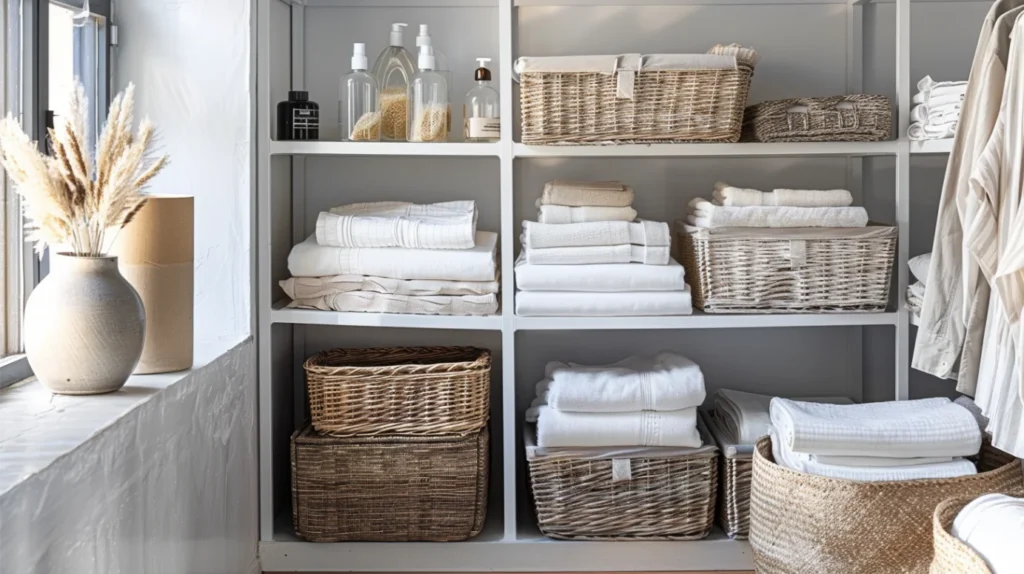As the seasons change, so do our storage needs. Whether you’re packing away winter coats or storing summer beach gear, efficient seasonal storage is key to maintaining an organized and clutter-free home. In this guide, we’ll explore innovative and practical ways to manage your seasonal items, ensuring they’re protected when not in use and easily accessible when you need them.
At GardenAndHomeHacks.com, the challenges of maintaining an organized living space year-round are well understood. This detailed list of smart organization tips can help master the art of seasonal storage. From maximizing closet space to utilizing unexpected areas in the home, these strategies will transform the approach to storage and organization.
Why Seasonal Storage Matters
Before diving into specific tips, let’s consider why seasonal storage is so important:
- Reduces clutter: By rotating items based on the season, you keep only what you need at hand, reducing overall clutter in your living spaces.
- Protects valuable items: Proper storage protects off-season items from damage, extending their lifespan.
- Saves time: With a well-organized system, you’ll spend less time searching for items when the seasons change.
- Maximizes space: Effective seasonal storage helps you make the most of your available space, no matter the size of your home.
Now, let’s explore some clever organization tips for tackling seasonal storage.

1. Assess and Declutter
Before you start organizing, take time to assess your seasonal items and declutter:
- Sort through everything: As you pack away one season’s items, review each piece. Ask yourself:
- Do I still use this?
- Is it in good condition?
- Does it fit?
- Be ruthless: If you haven’t used an item in the past year or two, consider donating or selling it.
- Create piles: Organize items into “keep,” “donate,” and “discard” piles to streamline the process.
Remember, the less you keep, the easier it is to store and organize what remains.
2. Invest in Quality Storage Solutions
The right storage containers can make a world of difference:
- Clear plastic bins: These are ideal for most seasonal items. They protect against dust and moisture while allowing you to see the contents.
- Vacuum-sealed bags: Perfect for bulky items like winter coats or bedding, these bags compress items to save space.
- Garment bags: Use breathable garment bags for storing delicate clothing items.
- Label everything: Clear, detailed labels are crucial for easy identification later.
Pro tip: Choose stackable containers to maximize vertical space in closets or storage areas.
3. Maximize Closet Space
Your closets are prime real estate for seasonal storage. Here’s how to make the most of them:
- Use vertical space: Install additional rods or shelves to double your hanging and stacking capacity.
- Over-the-door organizers: These are great for storing shoes, accessories, or small items.
- Closet systems: Consider investing in a customizable closet system to optimize every inch of space.
- Rotate clothes seasonally: Store off-season clothes in labeled bins on high shelves or under the bed.
4. Utilize Under-Bed Storage
The space under your bed is often overlooked but can be a storage goldmine:
- Low, wide containers: Look for containers specifically designed to fit under beds.
- Bed risers: Elevate your bed a few inches to create more storage space underneath.
- Vacuum bags: These are especially useful for under-bed storage, as they can compress bulky items like comforters and winter coats.
Remember: Out of sight doesn’t mean out of mind. Keep a list of what’s stored under each bed for easy reference.
5. Transform Your Attic or Basement
If you’re fortunate enough to have an attic or basement, make it work for your seasonal storage:
- Create zones: Designate areas for different seasons or types of items.
- Use shelving units: Install sturdy shelves to keep items off the floor and organized.
- Control the environment: Use dehumidifiers to prevent moisture damage, especially in basements.
- Insulate properly: Ensure your attic is well-insulated to protect items from extreme temperatures.

6. Get Creative with Unexpected Spaces
Think outside the box when it comes to storage locations:
- Behind doors: Use over-the-door hooks or organizers for items like wrapping paper or cleaning supplies.
- Above cabinets: The space above kitchen cabinets can store rarely-used seasonal items.
- Under stairs: Convert the area under stairs into pull-out storage drawers or shelving.
- Window seats: Build or repurpose window seats to include hidden storage compartments.
7. Organize by Season
Create a system that allows you to easily swap out seasonal items:
- Spring/Summer bin: Store lightweight clothing, gardening tools, and outdoor entertaining essentials.
- Fall bin: Pack away light jackets, Halloween decorations, and fall-themed items.
- Winter bin: Include heavy coats, snow gear, holiday decorations, and winter sports equipment.
Label each bin clearly and store the current season’s items in the most accessible locations.
8. Protect Delicate Items
Some seasonal items require special care:
- Holiday decorations: Use specialized storage containers for ornaments and lights to prevent breakage.
- Winter boots and shoes: Clean thoroughly before storing and use boot shapers to maintain their form.
- Summer gear: Clean and dry beach toys, umbrellas, and outdoor furniture before storing to prevent mold.
9. Digital Organization for Seasonal Items
Don’t forget about digital organization:
- Create an inventory: Keep a digital inventory of your stored items, including locations and contents of bins.
- Use apps: There are several apps designed to help you catalog and track stored items.
- Take photos: Snap pictures of bin contents for quick reference without having to open everything.
10. Implement a Rotation System
Develop a system for rotating your seasonal items:
- Set reminders: Use your phone or calendar to remind you when it’s time to switch out seasonal items.
- One in, one out: As you bring new seasonal items into rotation, remove and store an equal number of out-of-season items.
- Quarterly review: Every three months, reassess your storage needs and adjust accordingly.
11. Make Use of Vertical Space
Maximize your storage capacity by thinking vertically:
- Wall-mounted shelves: Install shelves in garages, basements, or utility rooms for additional storage.
- Pegboards: Great for organizing tools and smaller items in a visible, accessible way.
- Ceiling storage: In garages or basements, consider overhead storage systems for less frequently used items.

12. Create Multi-Functional Spaces
Look for opportunities to combine storage with everyday living areas:
- Ottoman storage: Choose ottomans or coffee tables with hidden storage compartments.
- Murphy beds: In guest rooms, a Murphy bed can free up floor space for storage when not in use.
- Dual-purpose furniture: Invest in items like storage benches or beds with built-in drawers.
13. Seasonal Clothing Care
Proper care of seasonal clothing ensures longevity:
- Clean before storing: Always clean items thoroughly before packing them away.
- Use cedar blocks: Place cedar blocks in storage containers to repel moths and absorb moisture.
- Avoid plastic dry cleaning bags: These can trap moisture and lead to yellowing of fabrics.
- Fold knits, hang wovens: To maintain shape, fold sweaters and knits, but hang items like dresses and blouses.
14. Eco-Friendly Storage Solutions
Consider environmentally friendly options for your storage needs:
- Repurpose household items: Use old suitcases, trunks, or dresser drawers for unique storage solutions.
- Fabric storage cubes: These are often made from recycled materials and are more eco-friendly than plastic.
- Bamboo organizers: Bamboo is a sustainable material that’s durable and attractive for storage.
15. Maintaining Your Storage System
Once you’ve implemented your seasonal storage system, maintain it:
- Regular purges: Conduct a thorough review of your stored items annually.
- Update your inventory: Keep your digital inventory up-to-date as you add or remove items.
- Clean storage areas: Regularly clean and inspect your storage spaces to prevent pest infestations or moisture damage.
Conclusion
Mastering seasonal storage is an ongoing process, but with these clever organization tips, you’ll be well on your way to a more organized, clutter-free home. Remember, the key to successful seasonal storage is creating a system that works for you and your living space. Don’t be afraid to experiment with different methods until you find the perfect solution.
By implementing these strategies, you’ll not only save space and time but also reduce stress and create a more harmonious living environment. Embrace the changing seasons with confidence, knowing that you have a smart, efficient system in place to handle whatever storage challenges come your way.
Do you have any unique seasonal storage tips that work well in your home? We’d love to hear about them! Share your ideas in the comments below and join the conversation on clever organization techniques.
